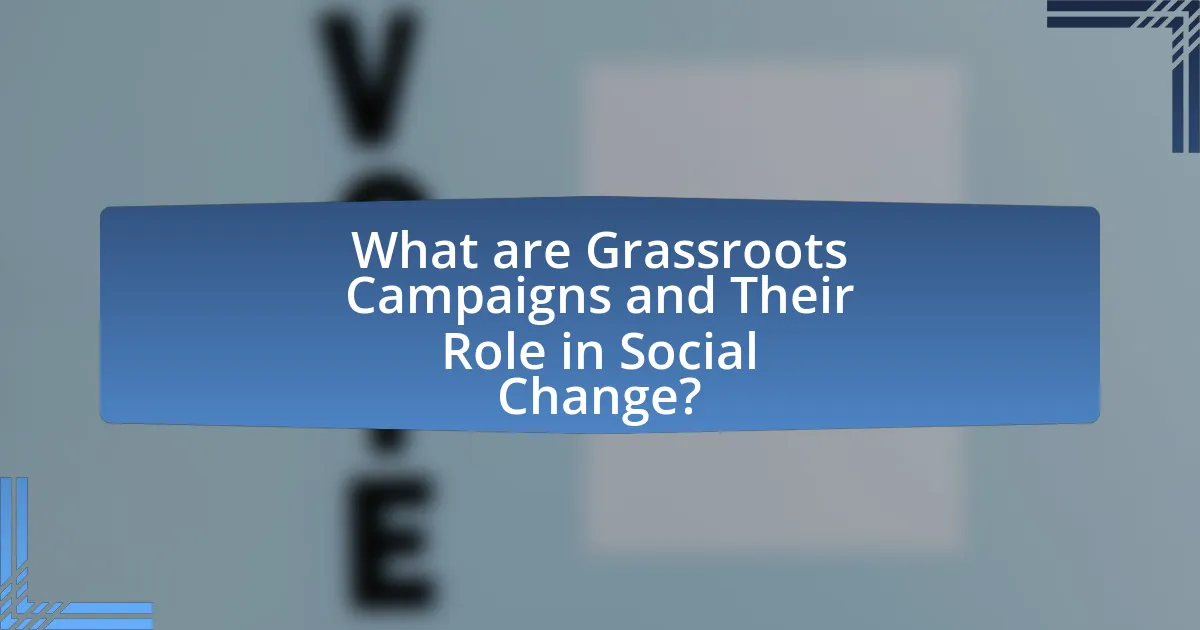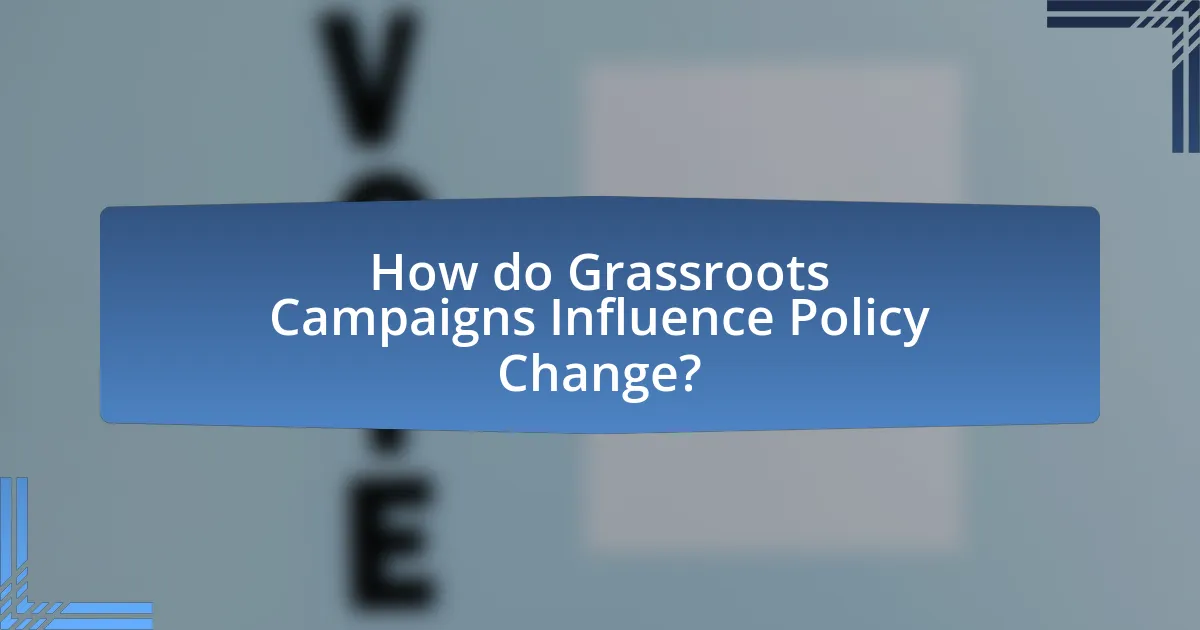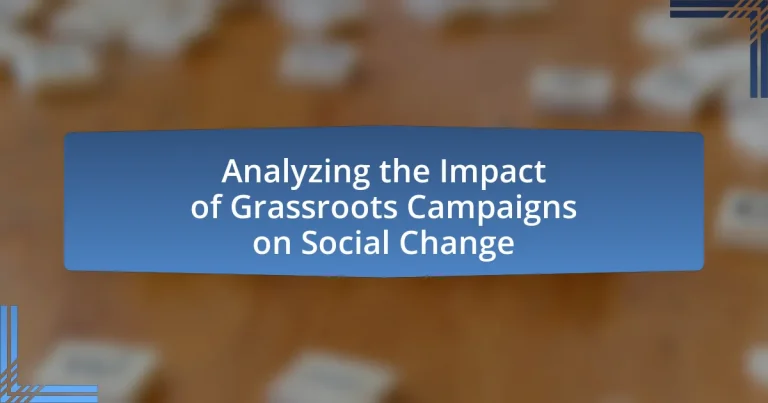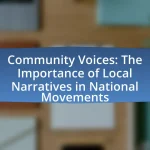Grassroots campaigns are organized efforts by ordinary individuals aimed at achieving social or political change within their communities. This article analyzes the role of grassroots campaigns in driving social change, highlighting their differences from traditional campaigns, common strategies employed, and their significance in community engagement. It explores historical examples, such as the Civil Rights Movement, to illustrate the impact of grassroots activism on policy changes and societal norms. Additionally, the article addresses the challenges faced by grassroots campaigns, including funding issues and media coverage, while offering best practices for enhancing their effectiveness and sustaining momentum over time.

What are Grassroots Campaigns and Their Role in Social Change?
Grassroots campaigns are organized efforts by ordinary people to effect social or political change at the community level. These campaigns mobilize individuals to advocate for specific issues, often leveraging local networks and resources to raise awareness and influence decision-makers. For example, the Civil Rights Movement in the United States utilized grassroots organizing to challenge segregation and promote equality, demonstrating the power of collective action in achieving significant social change. Research indicates that grassroots movements can lead to policy changes, increased civic engagement, and heightened public awareness, underscoring their critical role in shaping societal norms and policies.
How do Grassroots Campaigns differ from Traditional Campaigns?
Grassroots campaigns differ from traditional campaigns primarily in their approach to mobilization and funding. Grassroots campaigns rely on community involvement and small donations from individuals, emphasizing local engagement and volunteer efforts, while traditional campaigns often depend on large donations from wealthy individuals or organizations and focus on paid advertising and professional consultants. For example, the 2008 Obama campaign utilized grassroots strategies effectively, raising over $500 million from small donors, contrasting with traditional campaigns that typically prioritize big fundraising events and corporate sponsorships. This fundamental difference in funding and mobilization strategies influences the overall effectiveness and reach of the campaigns in driving social change.
What strategies are commonly used in Grassroots Campaigns?
Grassroots campaigns commonly utilize strategies such as community organizing, mobilization of volunteers, social media engagement, and coalition building. Community organizing involves identifying local leaders and fostering relationships to empower individuals to advocate for change. Mobilization of volunteers is crucial, as it leverages local support to amplify the campaign’s message and reach. Social media engagement allows campaigns to connect with a broader audience, share information rapidly, and mobilize supporters effectively. Coalition building involves partnering with other organizations to strengthen the campaign’s reach and impact, creating a united front for social change. These strategies have been proven effective in various historical movements, such as the Civil Rights Movement, where grassroots efforts significantly contributed to legislative changes.
Why are Grassroots Campaigns important for community engagement?
Grassroots campaigns are important for community engagement because they empower individuals at the local level to participate actively in social and political issues. These campaigns foster a sense of ownership and responsibility among community members, leading to increased civic participation. Research indicates that grassroots movements can mobilize large numbers of people, as seen in the 2011 Occupy Wall Street movement, which highlighted economic inequality and engaged diverse communities in dialogue and action. By addressing local concerns and leveraging community networks, grassroots campaigns create a platform for marginalized voices, ultimately driving social change and influencing policy decisions.
What historical examples illustrate the impact of Grassroots Campaigns?
Grassroots campaigns have significantly impacted social change, with notable historical examples including the Civil Rights Movement in the United States and the anti-apartheid movement in South Africa. The Civil Rights Movement, particularly from the 1950s to the 1960s, mobilized ordinary citizens through organizations like the Southern Christian Leadership Conference and the Student Nonviolent Coordinating Committee, leading to landmark legislation such as the Civil Rights Act of 1964 and the Voting Rights Act of 1965. Similarly, the anti-apartheid movement, driven by grassroots activism and international solidarity, culminated in the dismantling of apartheid laws in the early 1990s, showcasing the power of collective action in achieving political and social reform. These examples illustrate how grassroots efforts can effectively challenge systemic injustices and bring about substantial societal change.
How did the Civil Rights Movement utilize Grassroots Campaigns?
The Civil Rights Movement utilized grassroots campaigns by mobilizing local communities to advocate for social justice and equality. These campaigns involved organizing protests, sit-ins, and voter registration drives, which empowered individuals at the community level to take action against racial discrimination. For instance, the Student Nonviolent Coordinating Committee (SNCC) played a crucial role in grassroots organizing, particularly during the Freedom Summer of 1964, which aimed to increase voter registration among African Americans in Mississippi. This initiative resulted in the registration of thousands of new voters and highlighted the importance of local activism in driving national change.
What lessons can be learned from recent Grassroots Campaigns?
Recent grassroots campaigns demonstrate the importance of community engagement and mobilization in driving social change. These campaigns often succeed by leveraging local networks and fostering a sense of ownership among participants, which enhances commitment and participation. For instance, the Black Lives Matter movement effectively utilized social media to organize protests and raise awareness, resulting in significant policy discussions and changes in various jurisdictions. Additionally, data from the Pew Research Center indicates that grassroots movements can influence public opinion, as seen in the increased support for climate action following youth-led initiatives like the Fridays for Future protests. These examples illustrate that grassroots campaigns can effectively harness collective action to create meaningful societal impact.

How do Grassroots Campaigns Influence Policy Change?
Grassroots campaigns influence policy change by mobilizing community members to advocate for specific issues, thereby creating pressure on policymakers. These campaigns often utilize strategies such as organizing protests, leveraging social media, and engaging in direct lobbying to raise awareness and garner public support. For instance, the 2018 March for Our Lives movement, initiated by students advocating for gun control, successfully influenced legislative discussions and led to the introduction of new gun safety measures in several states. This demonstrates that grassroots efforts can effectively shift public opinion and compel lawmakers to respond to constituents’ demands, ultimately resulting in tangible policy changes.
What mechanisms do Grassroots Campaigns use to affect legislation?
Grassroots campaigns use mobilization, advocacy, and coalition-building as mechanisms to affect legislation. Mobilization involves organizing community members to participate in demonstrations, petitions, and lobbying efforts, which can create public pressure on lawmakers. Advocacy focuses on raising awareness and educating the public and legislators about specific issues, often utilizing social media and traditional media to amplify their message. Coalition-building brings together diverse groups to strengthen their collective voice, increasing influence and reach. For example, the 2018 March for Our Lives campaign effectively mobilized youth and community members to advocate for gun control legislation, resulting in significant policy discussions at local and national levels.
How do Grassroots Campaigns mobilize public opinion?
Grassroots campaigns mobilize public opinion by leveraging community engagement and direct action to influence political and social issues. These campaigns often utilize social media platforms, local events, and door-to-door outreach to connect with individuals, fostering a sense of collective identity and urgency around specific causes. For example, the 2018 March for Our Lives movement, initiated by students advocating for gun control, effectively galvanized public support through social media campaigns and organized protests, resulting in increased awareness and legislative discussions on gun reform. This demonstrates that grassroots efforts can significantly shape public discourse and drive policy changes by mobilizing individuals around shared values and goals.
What role does social media play in modern Grassroots Campaigns?
Social media serves as a crucial tool in modern grassroots campaigns by facilitating rapid communication, mobilization, and engagement among supporters. It allows campaign organizers to disseminate information quickly, rally volunteers, and gather donations, significantly enhancing outreach and participation. For instance, during the 2011 Arab Spring, social media platforms like Twitter and Facebook were instrumental in organizing protests and spreading awareness, demonstrating their power in grassroots movements. Additionally, a study by the Pew Research Center found that 69% of adults in the U.S. use social media, indicating a vast audience that grassroots campaigns can tap into for advocacy and support.
Why are Grassroots Campaigns effective in raising awareness?
Grassroots campaigns are effective in raising awareness because they mobilize community members to engage directly with issues that affect them. This localized approach fosters a sense of ownership and urgency, leading to higher levels of participation and advocacy. Research indicates that grassroots movements can significantly amplify voices that are often marginalized, as seen in the Civil Rights Movement, where community-led initiatives played a crucial role in raising awareness about racial injustices. Furthermore, studies show that grassroots campaigns often utilize social media and local networks to spread information rapidly, enhancing their reach and impact.
What tactics do Grassroots Campaigns use to spread their message?
Grassroots campaigns use community organizing, social media engagement, and direct outreach to effectively spread their message. Community organizing involves mobilizing local individuals to advocate for a cause, fostering a sense of ownership and collective action. Social media engagement allows campaigns to reach a broader audience quickly, utilizing platforms like Facebook and Twitter to share information and rally support. Direct outreach, such as door-to-door canvassing and phone banking, enables personal connections with potential supporters, enhancing message retention and commitment. These tactics have been shown to increase participation and awareness, as evidenced by the success of campaigns like the 2008 Obama presidential campaign, which effectively utilized grassroots strategies to mobilize millions of voters.
How do personal stories enhance the effectiveness of Grassroots Campaigns?
Personal stories enhance the effectiveness of grassroots campaigns by creating emotional connections that resonate with audiences. These narratives humanize issues, making them relatable and compelling, which can drive engagement and mobilization. Research indicates that campaigns utilizing personal stories can increase support by up to 30%, as they foster empathy and understanding among potential supporters. For example, the “It Gets Better” campaign effectively used personal testimonials to address LGBTQ+ youth issues, resulting in widespread visibility and support. This demonstrates that personal stories not only capture attention but also inspire action, thereby amplifying the overall impact of grassroots efforts.

What Challenges do Grassroots Campaigns Face?
Grassroots campaigns face several significant challenges, including limited funding, lack of media coverage, and difficulties in mobilizing volunteers. Limited funding restricts the ability to reach wider audiences and implement effective strategies, as many grassroots initiatives operate on tight budgets. Additionally, mainstream media often overlooks grassroots efforts, making it challenging to gain visibility and support. Mobilizing volunteers can also be difficult, as grassroots campaigns rely heavily on community engagement, which can fluctuate based on public interest and commitment levels. These challenges hinder the overall effectiveness and sustainability of grassroots movements in driving social change.
What are common obstacles encountered by Grassroots Campaigns?
Common obstacles encountered by grassroots campaigns include limited funding, lack of media coverage, and difficulty in mobilizing volunteers. Limited funding restricts the ability to reach wider audiences and implement effective strategies, as many grassroots campaigns operate on tight budgets. Lack of media coverage can hinder visibility and public awareness, making it challenging to gain traction for the cause. Additionally, difficulty in mobilizing volunteers can impede campaign efforts, as grassroots movements often rely on community engagement and participation to drive their initiatives forward. These challenges are frequently cited in studies examining the effectiveness of grassroots movements in enacting social change.
How do funding issues impact the success of Grassroots Campaigns?
Funding issues significantly hinder the success of grassroots campaigns by limiting their ability to mobilize resources effectively. Without adequate funding, grassroots organizations struggle to reach wider audiences, implement outreach strategies, and sustain long-term initiatives. For instance, a study by the National Committee for Responsive Philanthropy found that campaigns with robust financial backing are 50% more likely to achieve their goals compared to those with limited resources. This financial disparity often results in reduced visibility, fewer events, and diminished community engagement, ultimately impacting the campaign’s overall effectiveness in driving social change.
What strategies can overcome resistance from established institutions?
To overcome resistance from established institutions, grassroots campaigns can employ strategies such as building coalitions, leveraging data-driven advocacy, and engaging in strategic communication. Building coalitions with diverse stakeholders enhances credibility and amplifies voices, making it harder for institutions to ignore collective demands. Data-driven advocacy utilizes research and statistics to present compelling evidence that supports the campaign’s objectives, thereby challenging institutional narratives. Strategic communication involves crafting clear, relatable messages that resonate with the public and decision-makers, fostering a sense of urgency and support for change. These strategies have been effective in various movements, such as the Civil Rights Movement, where coalition-building and strategic messaging played crucial roles in overcoming institutional resistance.
How can Grassroots Campaigns sustain momentum over time?
Grassroots campaigns can sustain momentum over time by fostering community engagement and maintaining consistent communication with supporters. Engaging the community through regular events, updates, and feedback mechanisms helps to keep participants invested in the campaign’s goals. For instance, campaigns that utilize social media platforms to share success stories and mobilize supporters have shown increased participation rates. Research indicates that campaigns with strong grassroots networks can achieve a 20% higher retention rate of volunteers compared to those without such engagement strategies. Additionally, establishing clear, achievable milestones allows campaigns to celebrate progress, reinforcing motivation and commitment among supporters.
What role does community involvement play in sustaining Grassroots Campaigns?
Community involvement is crucial for sustaining grassroots campaigns as it fosters local ownership and engagement. When community members actively participate, they contribute to the campaign’s legitimacy and relevance, ensuring that the issues addressed resonate with their needs. Research indicates that campaigns with strong community ties are more likely to mobilize resources effectively and maintain momentum over time. For instance, a study by the Stanford Social Innovation Review found that grassroots initiatives that engaged local stakeholders saw a 50% increase in volunteer participation and a 30% rise in funding compared to those that did not prioritize community involvement. This evidence underscores the importance of community engagement in enhancing the sustainability and impact of grassroots campaigns.
How can Grassroots Campaigns adapt to changing political landscapes?
Grassroots campaigns can adapt to changing political landscapes by leveraging data analytics to understand voter sentiment and adjust their messaging accordingly. For instance, campaigns can utilize social media analytics to track shifts in public opinion and tailor their outreach strategies to resonate with current concerns. A study by the Pew Research Center in 2021 highlighted that 72% of Americans use social media, making it a vital tool for grassroots organizations to engage with constituents and respond to emerging issues in real-time. By being agile and responsive, grassroots campaigns can maintain relevance and effectively mobilize support amidst evolving political dynamics.
What Best Practices can enhance the effectiveness of Grassroots Campaigns?
Effective grassroots campaigns can be enhanced by building strong community relationships, utilizing social media strategically, and mobilizing volunteers effectively. Strong community relationships foster trust and engagement, which are essential for rallying support; for instance, campaigns that involve local leaders often see increased participation. Strategic use of social media allows for broader outreach and real-time communication, with studies showing that campaigns leveraging platforms like Facebook and Twitter can increase visibility and engagement by up to 60%. Mobilizing volunteers effectively ensures that resources are utilized efficiently, with successful campaigns often reporting that well-organized volunteer efforts can double the impact of outreach activities.
How can Grassroots Campaigns effectively measure their impact?
Grassroots campaigns can effectively measure their impact by utilizing a combination of quantitative and qualitative metrics. Quantitative metrics include tracking participation rates, fundraising totals, and social media engagement, which provide concrete data on the campaign’s reach and effectiveness. For instance, a study by the Pew Research Center found that campaigns with higher social media engagement correlate with increased public awareness and support, demonstrating the importance of digital metrics. Qualitative metrics involve gathering testimonials and feedback from participants and beneficiaries, which can reveal the campaign’s influence on community attitudes and behaviors. By analyzing both types of data, grassroots campaigns can gain a comprehensive understanding of their impact and make informed adjustments to their strategies.
What tools and resources are available for Grassroots Campaign organizers?
Grassroots campaign organizers have access to various tools and resources that enhance their effectiveness. Key tools include social media platforms like Facebook and Twitter for outreach, fundraising platforms such as GoFundMe and Kickstarter for financial support, and email marketing services like Mailchimp for communication. Additionally, organizers can utilize project management tools like Trello and Asana to coordinate efforts and track progress. Research from the Pew Research Center indicates that 69% of adults in the U.S. use social media, highlighting its importance in grassroots mobilization. Furthermore, resources such as the Grassroots Fundraising Journal provide insights and strategies specifically tailored for grassroots efforts, reinforcing the effectiveness of these tools in driving social change.


